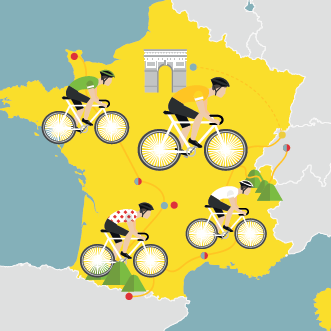Tour de France
The Tour de France is a bicycle race held annually in France, and sometimes in countries near France. It is a longdistance race which covers around 35,000 kilometres and takes about 23 days. The tour was first organized in 1903, which makes it the world’s oldest cycling race. Its only purpose then was to increase sales for a newspaper. Now it is the world’s most prestigious cycling race in terms of the points the riders gain. The winner of the Tour de France receives 200 points towards the UCI, the international ranking of cyclists. The winners of other big cycling races such as the Giro d’Italia, or Tour of Italy, receive 170 points, and smaller races give 100 points at most. The Tour de France is also the most famous cycling race in the world. The Giro d’Italia follows Tour de France as the second-most famous bicycle race.
The Tour de France usually takes place in the month of July each year with 20 to 22 teams participating in the race. On each team there are 9 riders. The rider who finishes the race the quickest becomes the leader of the race. Leaders wear the ‘Yellow Jersey’ which is a yellow t-shirt made with jersey material. In this way, the leader can be identified easily. The Tour de France was the first to use a yellow jersey to identify the leader, and now newer races such as the Tour of Germany have the same color. Other well established races have their own color systems. For example, the leader of the Giro d’Italia has a pink jersey. This is because the race’s original sponsor was a sports newspaper which printed on pink paper, like many European sports newspapers of the time.
In the race, riders compete in various categories. While the general category gathers the most attention, other contests are important for different methods and groups of riders as well: the points classification for the fast cyclists, the mountains classification for the climbers, the young rider classification for riders under the age of 26, and the team classification for the fastest teams.

